Vector multiplication - Study guides, Class notes & Summaries
Looking for the best study guides, study notes and summaries about Vector multiplication? On this page you'll find 204 study documents about Vector multiplication.
Page 3 out of 204 results
Sort by
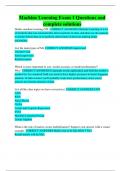
-
Machine Learning Exam 1 Questions and complete solutions
- Exam (elaborations) • 15 pages • 2023
- Available in package deal
-
- $14.99
- + learn more
Machine Learning Exam 1 Questions and complete solutions Define machine learning (ML) List the main types of ML Which is more important to you- model accuracy or model performance? Why? List all the class topics we have covered yet. What is the rule of matrix-vector multiplication? Support your answer with a visual example. What is the rule of matrix-matrix multiplication? Support your answer with a visual example. How would you represent the following example in a matrix mult...
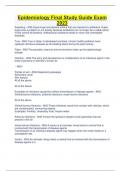
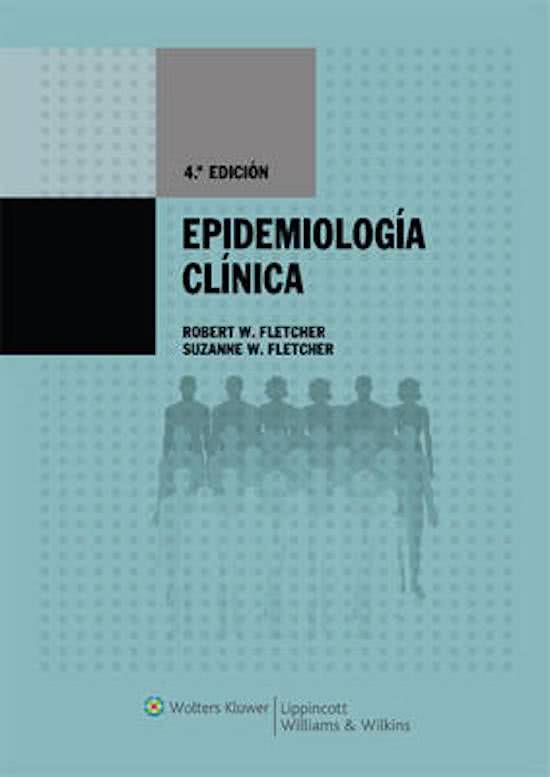
-
Epidemiology Final Study Guide Exam 2023
- Exam (elaborations) • 17 pages • 2023
-
- $12.99
- + learn more
Epidemiology Final Study Guide Exam 2023 Superbug - ANS-Super bugs are bacteria strains that are resistant to antibiotics. Super bugs pose a problem in our society because antibiotics can no longer be a viable option if they cannot kill bacteria. Antibacterial resistance leads to more now-untreatable diseases. True - ANS-True or false: In developed countries, chronic health problems have replaced infectious diseases as the leading killers during the past century. False - ANS-The par...
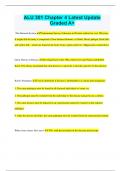
-
ALU 301 Chapter 4 Latest Update Graded A+
- Exam (elaborations) • 17 pages • 2024
-
- $9.99
- + learn more
ALU 301 Chapter 4 Latest Update Graded A+ The Humoral System Predominant theory of disesase in Western culture for over 200 years. It taught that the body is composed of four balanced humors, or fluids: blood, phlegm, black bile, and yellow bile - which are found in the heart, brain, spleen and liver. (Hippocrates created this.) Germ Theory of Disease Developed late in the 19th century by Louis Pateur and Robert Koch. This theory postulated that each disease is caused by a microbe sp...
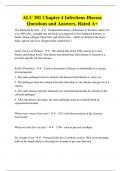
-
ALU 301 Chapter 4 Infectious Disease Questions and Answers, Rated A+
- Exam (elaborations) • 13 pages • 2024
- Available in package deal
-
- $13.99
- + learn more
The Humoral System - Predominant theory of disesase in Western culture for over 200 years. It taught that the body is composed of four balanced humors, or fluids: blood, phlegm, black bile, and yellow bile - which are found in the heart, brain, spleen and liver. (Hippocrates created this.) Germ Theory of Disease - Developed late in the 19th century by Louis Pateur and Robert Koch. This theory postulated that each disease is caused by a microbe specific for that disease. Koch's Postu...

-
Fourier Transform Test 1 Questions with Correct Answers
- Exam (elaborations) • 4 pages • 2024
- Available in package deal
-
- $12.39
- + learn more
Fourier Transform Test 1 Questions with Correct Answers Why doesn't the normalisation vectors apply to the DC-component (values at t=0)? - Answer-Because the DC component don't have a negative counterpart. It's the average value of all data points. How does amplitude in time and frequency domain differ? - Answer-The amplitude is the length of the complex vector in frequency, hence it cannot be negative. Amplitude in time-domain, however, indicates direction in addition to magnitude and...
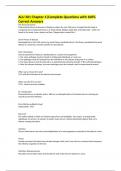
-
ALU 301 Chapter 4|Complete Questions with 100% Correct Answers Graded A+
- Exam (elaborations) • 9 pages • 2024
- Available in package deal
-
- $9.69
- + learn more
ALU 301 Chapter 4|Complete Questions with 100% Correct Answers The Humoral System Predominant theory of disesase in Western culture for over 200 years. It taught that the body is composed of four balanced humors, or fluids: blood, phlegm, black bile, and yellow bile - which are found in the heart, brain, spleen and liver. (Hippocrates created this.) Germ Theory of Disease Developed late in the 19th century by Louis Pateur and Robert Koch. This theory postulated that each disease is cause...
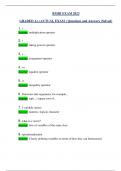
-
RMHI EXAM 2023 GRADED A+ (ACTUAL EXAM ) Questions and Answers (Solved)
- Exam (elaborations) • 23 pages • 2023
-
- $10.99
- + learn more
RMHI EXAM 2023 GRADED A+ (ACTUAL EXAM ) Questions and Answers (Solved) 1. * Answer: multiplication operator 2. ^ Answer: taking powers operator 3. < - Answer: assignment operator 4. == Answer: equality operator 5. != Answer: inequality operator 6. Functions take arguments, for example... Answer: sqrt(...) square root of... 7. 3 variable classes Answer: numeric, logical, character 8. what is a vector? Answer: lists of variables of the same class 9. operationalization Answer...

-
Para lec midterm
- Exam (elaborations) • 43 pages • 2024
-
- $14.29
- + learn more
Para lec midterm Para lec midterm PARASITOLOGY LECTURE MIDTERMS WEEK 8: SPOROZOA (PLASmODIUm SPP. AND BABESIA SPP.) Acanthamoeba Entamoeba dispar Endolimax nana Entamoeba gingivalis Entamoeba coli Entamoeba histolytica Iodamoeba butschlii Naegleria fowleri SUBPHYLUM MASTIGOPHORA Chilomastix mesnili Dientamoeba fragilis Giardia lamblia Trichomonas vaginalis Trichomonas hominis Trichomonas tenax Trichomonas vaginalis Leishmania braziliensis Leishma...
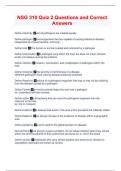
-
NSG 310 Quiz 2 Questions and Correct Answers
- Exam (elaborations) • 9 pages • 2024
- Available in package deal
-
- $9.99
- + learn more
Define infectivity not all pathogens are created equally Define pathogen microorganisms that are capable of causing infectious disease; categorized as viruses bacteria, and fungi Define host The human or animal invaded and colonized by a pathogen Define Colonization a pathogen living within the host, but does not mean infection exists (not always causing the problem) Define infection invasion, colonization, and multiplication of pathogens within the host Define Virulence the severity or har...
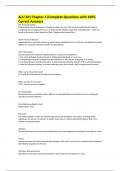
-
ALU 301 Chapter 4|Complete Questions with 100% Correct Answers
- Exam (elaborations) • 9 pages • 2024
- Available in package deal
-
- $10.39
- + learn more
ALU 301 Chapter 4|Complete Questions with 100% Correct Answers The Humoral System Predominant theory of disesase in Western culture for over 200 years. It taught that the body is composed of four balanced humors, or fluids: blood, phlegm, black bile, and yellow bile - which are found in the heart, brain, spleen and liver. (Hippocrates created this.) Germ Theory of Disease Developed late in the 19th century by Louis Pateur and Robert Koch. This theory postulated that each disease is cause...

How did he do that? By selling his study resources on Stuvia. Try it yourself! Discover all about earning on Stuvia


